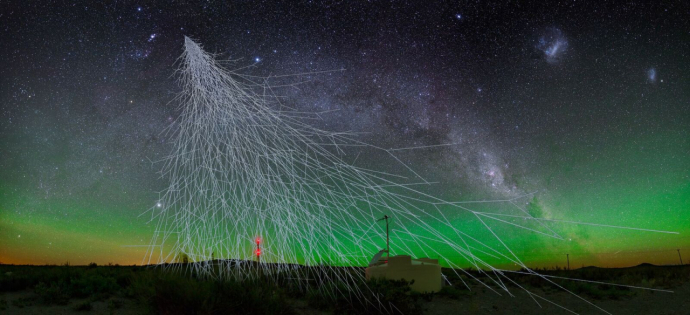From galaxies far far away!
In a paper published in Science on 22 September 2017, the Pierre Auger Collaboration reports observational evidence demonstrating that cosmic rays with energies a million times greater than that of the protons accelerated in the Large Hadron Collider come from much further away than from our own Galaxy. Ever since the existence of cosmic rays with individual energies of several Joules was established in the 1960s, speculation has raged as to whether such particles are created there or in distant extragalactic objects. The 50 year-old mystery has been solved using cosmic particles of mean energy of 2 Joules recorded with the largest cosmic-ray observatory ever built, the Pierre Auger Observatory in Argentina. It is found that at these energies the rate of arrival of cosmic rays is ~6% greater from one half of the sky than from the opposite one, with the excess lying 120˚ away from the Galactic centre.
In the view of Professor Karl-Heinz Kampert (University of Wuppertal), spokesperson for the Auger Collaboration, which involves over 400 scientists from 18 countries, “We are now considerably closer to solving the mystery of where and how these extraordinary particles are created, a question of great interest to astrophysicists. Our observation provides compelling evidence that the sites of acceleration are outside the Milky Way”. Professor Alan Watson (University of Leeds), emeritus spokesperson, considers this result to be “one of the most exciting that we have obtained and one which solves a problem targeted when the Observatory was conceived by Jim Cronin and myself over 25 years ago”.
 An artist’s rendering of a cosmic-ray air shower with a water-Cherenkov detector of the Pierre Auger Observatory in western Argentina (credit: A. Chantelauze, S. Staffi and L. Bret).
An artist’s rendering of a cosmic-ray air shower with a water-Cherenkov detector of the Pierre Auger Observatory in western Argentina (credit: A. Chantelauze, S. Staffi and L. Bret).
Cosmic rays are the nuclei of elements from hydrogen (the proton) to iron. Above 2 Joules the rate of their arrival at the top of the atmosphere is only about 1 per sq km per year, equivalent to one hitting the area of a football pitch about once per century. Such rare particles are detectable because they create showers of electrons, photons and muons through successive interactions with the nuclei in the atmosphere. These showers spread out, sweeping through the atmosphere at the speed of light in a disc-like structure, similar to a dinner-plate, several kilometres in diameter. They contain over ten billion particles and, at the Auger Observatory, are detected through the Cherenkov light they produce in a few of 1600 detectors, each containing 12 tonnes of water, spread over 3000 km2 of Western Argentina, an area comparable to that of Rhode Island. The times of arrival of the particles at the detectors, measured with GPS receivers, are used to find the arrival directions of events to within ~1˚.
By studying the distribution of the arrival directions of more than 30000 cosmic particles the Auger Collaboration has discovered an anisotropy, significant at 5.2 standard deviations (a chance of about two in ten million), in a direction where the distribution of galaxies is relatively high. Although this discovery clearly indicates an extragalactic origin for the particles, the actual sources have yet to be pinned down. The direction of the excess points to a broad area of sky rather than to specific sources as even particles as energetic as these are deflected by a few 10s of degrees in the magnetic field of our Galaxy. The direction, however, cannot be associated with putative sources in the plane or centre of our Galaxy for any realistic configuration of the Galactic magnetic field.
Cosmic rays of even higher energy than the bulk of those used in this study exist, some even with the kinetic energy of well-struck tennis ball. As the deflections of such particles are expected to be smaller, the arrival directions should point closer to their birthplaces. These cosmic rays are even rarer and further studies are underway using them to try to pin down which extragalactic objects are the sources. Knowledge of the nature of the particles will aid this identification and work on this problem is targeted in the upgrade of the Auger Observatory to be completed in 2018. Czech scientists have been collaborating on the construction and operation of the Pierre Auger Observatory since the very beginning of the experiment. The involved scientists come in particular from the Institute of Physics of the Czech Academy of Sciences, Charles University and Palacky University in Olomouc. The most important Czech contribution to the construction of the Observatory was the design, manufacture and installation of mirrors used in more than a half of the telescopes of the fluorescence detector. Nevertheless, the Czech scientist take part in other tasks, such as ensuring smooth operation of the Observatory, data analysis with focus on the search of sources of cosmic rays and identification of the types of observed particles, as well as monitoring of the atmospheric transparency and other technical parameters of the experiment.
The Czech participation in the Pierre Auger Observatory receives long-term support from the Ministry of Education, Youth and Sports of the Czech Republic (MŠMT ČR). Currently, the support comes from the project of large scientific infrastructures LM2015038 and EU-MŠMT CZ.02.1.01/0.0/0.0/16_013/0001402. The data analysis is supported by the project MŠMT ČR LG15014.
Dušan Mandát, Petr Trávníček